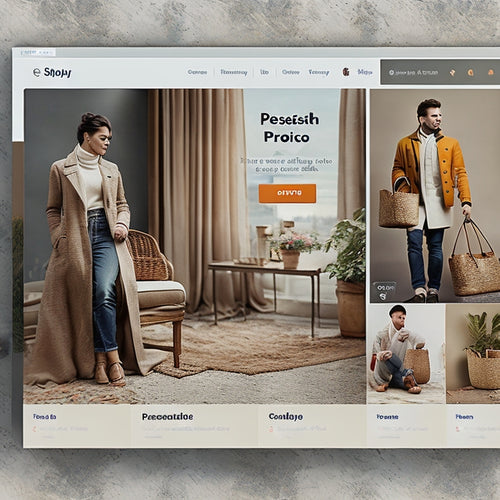
10 Proven Ecommerce Customer Retention Strategies
Share
You're likely to lose up to 75% of your customers if you don't have a solid customer retention strategy in place. To drive repeat business and sustain long-term growth, you need to implement proven ecommerce customer retention strategies. Start by personalizing your customer's online experience using data and analytics, and implement a loyalty rewards program that offers exclusive discounts and perks. Craft targeted email campaigns, provide multi-channel support, and enhance product recommendations using AI-powered algorithms. You can also leverage user-generated content, create valuable content assets, and conduct regular customer feedback. By implementing these strategies, you'll be well on your way to increasing customer loyalty and retention - and there's even more you can do to take your strategy to the next level.
Key Takeaways
• Implement personalized customer experiences using customer data and analytics to increase loyalty and retention.
• Develop loyalty rewards programs with tiered benefits and clear communication to incentivize repeat purchases.
• Craft targeted email marketing campaigns that re-engage inactive customers and offer strategic promotions along the customer journey.
• Provide seamless multi-channel support, including live chat and social media, to enhance customer experience and loyalty.
• Leverage user-generated content, such as customer reviews and ratings, to build trust and increase conversions by up to 10%.
Personalize Customer Experience Online
By leveraging customer data and analytics, you can create a tailored online experience that speaks directly to your customers' needs and preferences, increasing the likelihood of repeat business and loyalty. This is achieved by implementing customized recommendations that suggest relevant products based on their browsing and purchasing history.
Interactive chatbots can also be used to provide 24/7 support, helping customers find what they're looking for and resolving issues promptly. Additionally, tailored promotions can be sent to customers based on their preferences, increasing the likelihood of conversion. Personalized emails can also be used to nurture relationships, share exclusive offers, and celebrate milestones.
Offer Loyalty Rewards Programs
Implementing a well-structured loyalty rewards program can boost customer retention. Research shows that loyalty program members tend to spend more and make repeat purchases more frequently than non-members. You can design a points system that rewards customers for every purchase, review, or referral they make. This encourages repeat business and fosters brand loyalty.
As customers accumulate points, they can redeem them for exclusive discounts, free shipping, or other perks.
To make your loyalty program even more effective, consider offering tiered rewards. Customers who reach a certain points threshold can access premium rewards, such as early access to new products or dedicated customer support. By recognizing and rewarding your most loyal customers, you'll create a sense of belonging and appreciation, driving retention rates even higher.
Remember to communicate the program's benefits clearly and transparently, so customers understand how to earn and redeem points. With a well-designed loyalty rewards program, you'll be able to retain customers, increase sales, and gain a competitive edge in the market.
Implement Email Marketing Campaigns
You can greatly enhance customer retention by crafting targeted email marketing campaigns that speak directly to your customers' needs and preferences. By doing so, you'll be able to re-engage inactive customers, encourage repeat purchases, and build strong relationships with your customers.
To achieve this, create segmented campaigns that cater to specific customer groups based on their demographics, purchase history, or behavior. This will allow you to tailor your messaging and offers to resonate with each group.
To maximize efficiency, set up automated workflows that trigger emails at strategic points in the customer journey. For instance, you can send a welcome email with a discount code to new subscribers, or a cart abandonment email to customers who left items in their cart.
By automating these workflows, you'll save time and resources while ensuring that your customers receive timely and relevant communications.
Provide Multi-Channel Support Options
Today's customers expect seamless support experiences across various touchpoints, so offering multi-channel support options becomes essential to meeting their evolving needs and expectations.
You can't afford to limit your customers to a single channel, as this can lead to frustration and, ultimately, churn. By providing multiple channels, you're allowing customers to choose how they want to interact with your brand.
For instance, you can implement live chat on your website, enabling customers to get instant support while browsing your products. Additionally, you can leverage social media to respond to customer inquiries and concerns in a public forum, showcasing your commitment to customer satisfaction.
This omnichannel approach not only enhances the customer experience but also increases brand loyalty. According to a study, 75% of customers expect consistent engagement across all channels, and 67% are more likely to make a purchase from a brand that offers consistent support.
Enhance Product Recommendations
By leveraging AI-powered algorithms and customer data, personalize product recommendations to bridge the gap between what customers are buying and what they actually need. This approach will help you increase customer engagement and encourage cross-selling techniques.
For instance, if a customer frequently purchases skincare products, suggest complementary items like moisturizers or face masks. You can also use personalized offers to target specific customer segments, such as loyalty program members or repeat buyers.
To take it a step further, use targeted marketing campaigns to promote relevant products based on individual customer preferences. For example, if a customer has shown interest in eco-friendly products, send them emails featuring sustainable brands or promotions. By doing so, you'll demonstrate a deep understanding of their needs, fostering a sense of loyalty and appreciation.
Streamline Return Shipping Process
As online shoppers increasingly expect seamless experiences, a hassle-free return shipping process has become a key differentiator in ecommerce customer retention. You can't afford to neglect this important aspect of your customer experience.
A well-designed return policy can greatly impact customer satisfaction and loyalty. In fact, a study found that 92% of customers will repeat business with a company that offers a hassle-free return experience.
To streamline your return shipping process, start by making your return policy easily accessible and transparent. Clearly outline the steps customers need to take to initiate a return, and provide a seamless experience through a pre-paid return shipping label or a hassle-free exchange process. By doing so, you'll reduce friction and anxiety, leading to higher customer satisfaction rates.
Create Valuable Content Assets
Developing valuable content assets is essential to ecommerce customer retention. It allows you to educate, entertain, and inspire your customers, fostering a deeper connection with your brand. By creating high-quality content, you can establish your brand as an authority in your industry, building trust and credibility with your customers.
Effective content marketing strategies can increase customer engagement and drive loyalty and retention. For instance, you can create blog posts that provide solutions to common pain points or produce videos that showcase your products in action. This type of content not only informs but also entertains, making your brand more relatable and memorable.
Conduct Regular Customer Feedback
Regularly soliciting customer feedback is essential to refining your ecommerce strategy, as it allows you to tap into the minds of your customers and pinpoint areas for improvement. By collecting feedback, you can identify pain points, optimize your customer journey, and increase customer satisfaction.
You can use survey analytics tools to gather and analyze feedback, providing you with actionable insights to inform your business decisions. For instance, you can use surveys to ask customers about their shopping experience, product quality, and customer support. This will help you understand what's working and what's not, allowing you to make data-driven changes to improve customer satisfaction.
Develop VIP Customer Segments
By identifying and segmenting your most loyal and profitable customers, you can create a VIP program that rewards their repeat business and encourages continued loyalty. A customer segmentation analysis helps you identify these high-value customers based on their purchase history, frequency, and overall lifetime value.
Once you've pinpointed your VIPs, you can develop a tailored program that offers exclusive benefits and personalized experiences.
These VIP customer benefits can include early access to new products, exclusive promotions, and priority customer support. You can also offer personalized experiences, such as curated product recommendations or early notifications about sales and restocks.
By recognizing and rewarding your most loyal customers, you'll foster a sense of appreciation and belonging, encouraging them to continue doing business with you. In fact, studies show that VIP programs can increase customer retention rates by up to 25%.
Leverage User-Generated Content
You can further fuel customer loyalty and retention by leveraging user-generated content, which not only builds trust and social proof but also provides valuable insights into your customers' needs and preferences.
By showcasing real customers' experiences and opinions, you can create a sense of community and authenticity that drives engagement and loyalty.
For instance, featuring customer reviews, ratings, and testimonials on your website can increase conversions by up to 10%. Additionally, partnering with influencers who align with your brand values can amplify your reach and credibility. According to a study, 92% of consumers trust influencer partnerships more than traditional advertising.
Frequently Asked Questions
How Do I Measure the Success of My Customer Retention Strategies?
"You're drowning in a sea of customer data, but measuring retention success is a lifesaver! Track your churn rate analysis, calculate customer lifetime value, and evaluate engagement metrics while conducting satisfaction surveys to gauge your strategies' true impact."
What Is the Ideal Frequency for Loyalty Rewards and Promotions?
You'll find the ideal frequency for loyalty rewards and promotions by balancing reward timing to maximize customer engagement, while ensuring promotional effectiveness doesn't overwhelm, ultimately boosting customer satisfaction.
Can I Use Customer Feedback to Improve My Product Development?
You craft clever customer connections by collecting candid critiques, implementing surveys and focus groups to fuel iterative improvements, and leveraging customer insights to refine your product development, driving data-driven decisions that delight demanding devotees.
How Do I Balance Personalization With Customer Data Privacy Concerns?
You must balance personalization with customer data privacy concerns by implementing robust data security measures, complying with privacy regulations, and being transparent about data usage to build customer trust and maintain a delicate balance.
What Is the Average ROI of Investing in Customer Retention Efforts?
You'll find that investing in customer retention typically yields an average ROI of 5:1 to 7:1, as increasing customer lifetime value by just 5% can boost profits by 25-95%, contingent on retention campaign effectiveness.
Related Posts
-
What Are Some Effective Ways to Leverage Product Demonstrations Through Video to Drive Sales?
In today's digital age, businesses are constantly seeking innovative ways to drive sales and capture the attention o...
-

Why Business Owners Need Online Learning Platforms
You need an online learning platform to stay ahead of the curve in today's fast-paced business environment, where ada...
-

Optimize Your Shopify Cart Experience With Top Upsell Apps
This article explores the optimization of the shopping experience on Shopify websites through the use of cart upsell...

